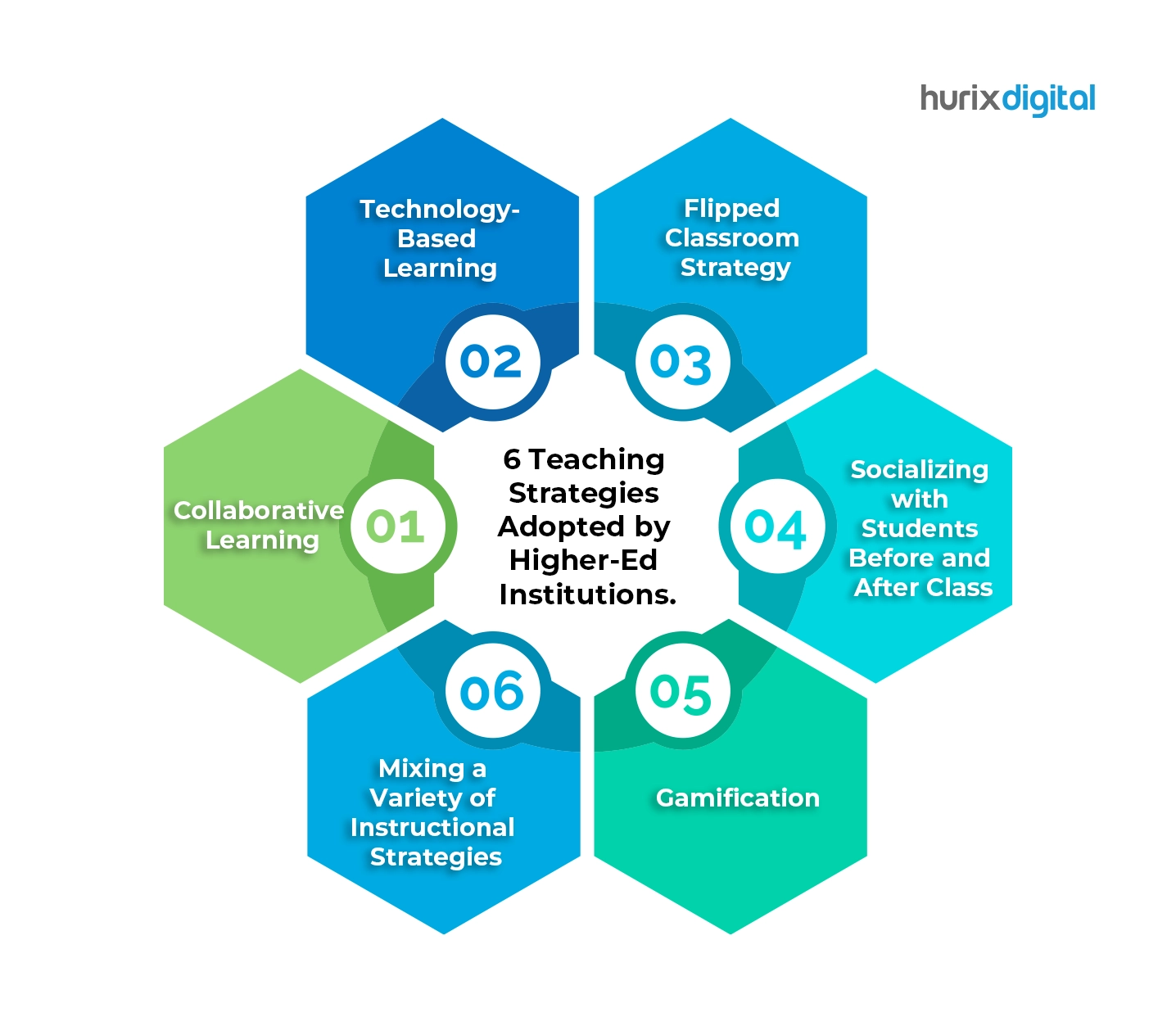Top 6 Teaching Strategies Adopted By Higher-ed Institutions Post-Covid
Summary
The blog post discusses teaching strategies adopted by higher education institutions during the COVID-19 pandemic, and uses a mix of instructional strategies to facilitate online learning and keep students engaged.
Table of Contents:
- Introduction
- Six Teaching Strategies Adopted by Higher-Ed Institutions:
1. Collaborative Learning
2. Technology-Based Learning
3. Flipped Classroom Strategy
4. Socializing with Students Before and After Class
5. Gamification
6. Mixing a Variety of Instructional Strategies - Conclusion
Introduction
The COVID-19 pandemic has brought significant changes to the education system as a whole. With most teaching and learning activities moving online, higher-ed institutions had to think about various solutions to facilitate seamless learning and maintain student engagement.
This blog discusses some of these teaching and learning strategies in higher education adopted by higher-ed institutions in the post-COVID era.
Six teaching strategies adopted by higher-ed institutions.

1. Collaborative Learning
Collaborative learning is a modern teaching method widely adopted by colleges and universities in the post-COVID world where instructors form a group of students and allow them to solve their problems, hold debates/discussions on topics, and clear their queries. It is among the most booming post-COVID teaching strategies that help students to develop social skills and understand the subject/content faster.
The key benefit of this teaching strategy is that every student plays a role in the success of a group as they work in collaboration and support each other to reach the desired result, along with learning to communicate with each other.
The strategy also allows learners to develop skills such as active listening and how to work together in a team. It enables them to meet and work with different personalities and get genuine feedback on their work.
2. Technology-Based Learning
When it comes to online learning, it is essential to leverage technology effectively. Therefore, an increasing number of higher-ed instructors are leveraging technology in their higher education teaching strategies, such as smart boards and webinars, to help students learn better.
One of the advantages of these tools is the flexibility offered by them. For instance, a small smart board can be carried almost anywhere and allows instructors to create a good visualization (various colors, text types, graphs) for the topic being taught for better student understanding. The best part about using these smartboards during webinars is the efficiency and creativity they offer in delivering online course content.
Further, these smartboards, in combination with robust video editing software, allow instructors to edit the entire lecture and send it to students as documents via email.
3. Flipped Classroom Strategy
A flipped classroom is a popular pedagogical method that is gaining popularity again in the post-COVID world. It refers to one of the vital modern teaching methods where the teaching procedure is flipped.
Unlike traditional teaching methods, in a flipped classroom strategy, learners study new material/content independently and practice the same at college (physically/virtually). Put simply, this method is the reverse of offering content in class and asking students to practice it at home. The main advantage of a flipped classroom teaching strategy is that students get enough time to understand the topic. Further, the strategy also enables students to suggest ideas related to the content and share them with their peers.
4. Socializing with Students Before and After Class
With online learning, socialization- one of the important aspects of learning-is completely missing. That is why many instructors are now adapting the inclusiveness of socialization in their teaching strategies for higher education and online teaching to help learners alleviate the lack of motivation. Some of the ways they are doing this include-
Virtual tours & interactive forums
Instructors use these virtual hours & interactive forums to start new discussions, giving a space for students to ask questions, submit assignments, etc.
Online meetups
Instructors create online meetups via various online videos concerning services such as Zoom, Google Hangouts, and Skype. They use this space to discuss student concerns, questions, or suggestions to improve the class.
5. Gamification
One of the most exciting teaching strategies in higher education, teaching through games is one of the common methods that colleges have adopted in today’s time. Unlike the popular notion that gamification techniques are significant only in the elementary and preschool system, they are equally effective for higher-ed students.
However, the responsibility of making teaching through gamification effective is on instructors as they need to design and plan projects that are most suited for their students.
The need is to incorporate various interesting techniques and gamification strategies to engage students for a longer time. There are several online platforms under gamification, such as online quizzes, games, puzzles, and more for higher-ed students that instructors can take help from.
6. Mixing a Variety of Instructional Strategies
With online learning getting mainstream in today’s environment, it has become important for instructors to mix things up and use various instructional strategies to keep the students engaged. The availability of technology makes it easy for instructors to create virtual learning environments that allow learners to collaborate and engage just as well as if they were in the classroom.
Online learning instructors use a combination of different teaching strategies for college students based on learning resources and styles, thus creating a blend of traditional learning methods with newer, more collaborative audio and visual tech tools. This makes the content for the college teaching strategies much more interesting and exciting, thus increasing learner engagement. The course, for instance, should have a mix of debates, discussions, collaboration, video and audio clips, and hands-on exercises with text and brief video lectures to keep students engaged throughout.
Some of the other strategies that educators are adopting include:
Dividing the content into short chunks
Lengthy lessons aren’t the best way to engage students in either physical or online classes. Instructors, therefore, are trying and breaking the lesson into 10 or 15-minute short lessons to help students learn effectively.
Using a variety of learning tools
To make lessons interactive and fun, educators use a mix of learning tools such as online resources, templates, slideshows, presentations, and more.
In conclusion
Using and applying the above-mentioned teaching methods and strategies for college students allow the instructors to transform the overall online teaching experience into a more interactive one that can keep their learners motivated to learn both online and physically during and post-COVID-19. Incorporating a mix of these teaching methods in higher education is sure to make your university teaching strategies worthwhile for your students.

Senior Vice President – Business Development
Over 25 years of experience in the edtech and workforce learning industry with strong skills in Business Development, Customer Relationship Management (CRM) and Strategy.









